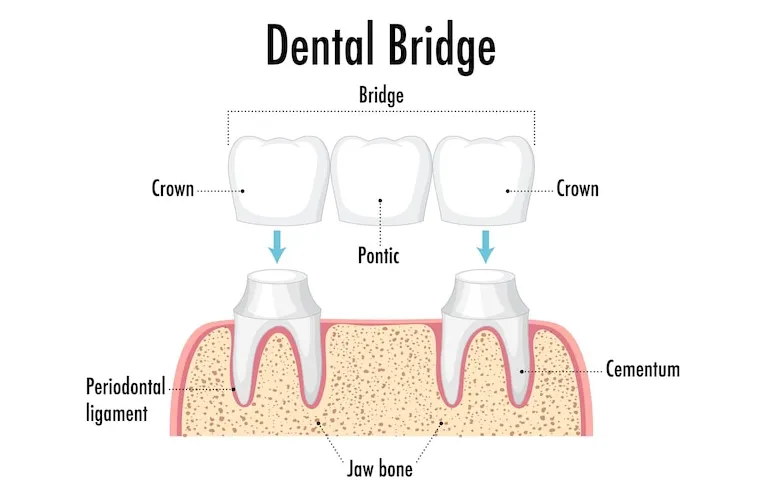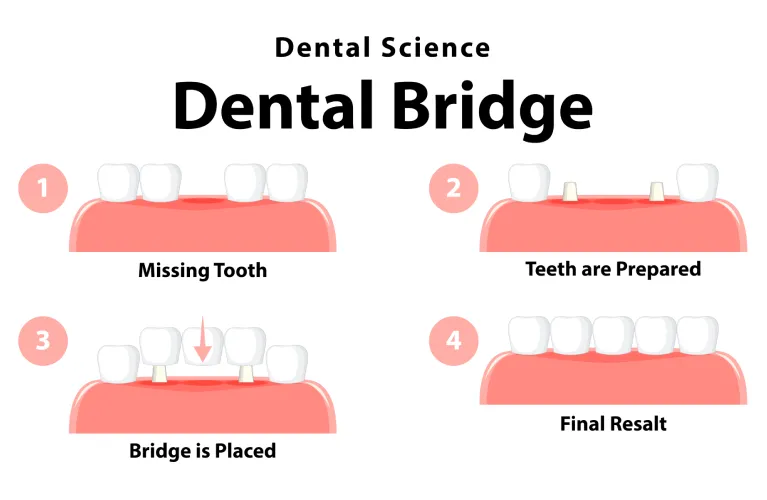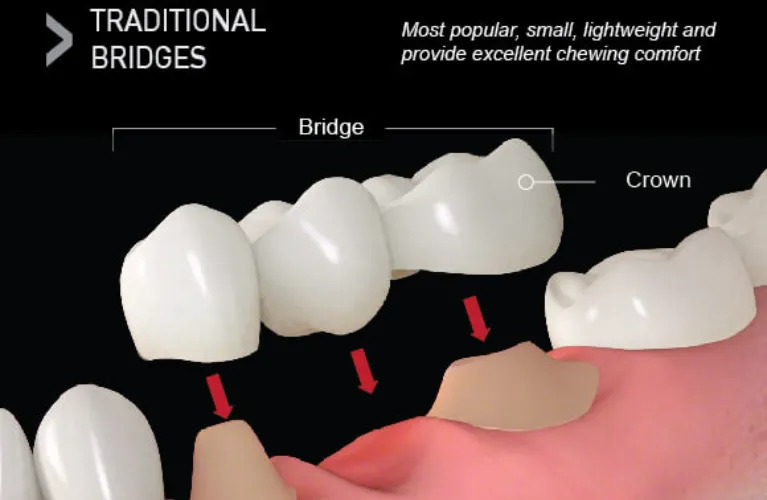
Dental Bridge: 4 Types, Benefits, Use Case, and Costs
When a gap caused a missing tooth has been found, a dental bridge can bridge this gap to either prevent natural tooth loss from prevent tooth decay, or gum disease and the missing tooth from becoming tooth decay too. An implanted bridge is a false tooth inserted through the gap created between the teeth.
Although pontics are from porcelain fused to metal made from various materials including gold, we construct them from porcelain fused to metal, to blend nicely with natural teeth and look natural in your natural teeth too. Continue reading.

Why do I need a dental bridge?
Your teeth work together. If a tooth is missing, nearby teeth can move into the space. The adjacent teeth in your opposite jaw can also move up or down toward the space. This can cause:
- Bite problems
- Chewing difficulties.
- Pain from the extra stress on your teeth and jaw.
- Self-consciousness is about the way you look or your smile.
What does a dental bridge look like?
Abutment teeth:
A dental professional places two crowns on the teeth on either side of the gap. These anchoring teeth, or supporting teeth, can be your natural teeth or dental implants.
Pontics:
This false tooth (or teeth) fills in the gap and attaches to the crowns.


What happens during a dental bridge procedure?
The dentist will first look at your mouth to see if you have tooth decay. They can make an x-ray and have a dental instrument to examine teeth and gums. A
We usually prepare dental bridges using two healthy teeth in each part. They take out Moulds that will be needed for constructing the bridges.
You may have temporary bridges while you await your permanent bridge. Upon the completion of the permanent dental bridge procedure, this will happen. The fixed bridge, or temporary or permanent bridge, usually has a protective adhesive on its side with dental cement.
Types Of Dental Bridges
Traditional dental bridge
Traditionally, dental bridges comprise removable false teeth, held in the mouth by dental crowns which are firmly attached to the abutment of existing front teeth.
We also use other false teeth as other types of dental bridges. The traditional dental bridge procedure is best used if you do not wear any false teeth, and have missing teeth.


Implant-Supported Bridge
The implant-supported dental bridge change requires surgery to insert the implants to the jawbone and recover. The healing time for implant-supported dental bridges also varies depending on how far into the bone loss the jaw bone the implants are located or the bone size required for support.
Your temporary dental implant-supported bridges bridge can be worn until your next dental appointment when the permanent dental, implant-supported bridges bridge we place part over the implants. It involves a small incision in the teeth causing the patient to experience healing time faster than that for other dental implant-supported bridge procedure procedures.
Cantilever Bridge
A dental for only one abutment tooth/teeth has soon as possible after preparing the other abutment teeth or tooth abutment teeth first. The dental practitioner removes enamel and dentin from the gumline to create the crowns for only one abutment tooth or multiple teeth together.
Afterwards, they can place temporary bridges on those abutment teeth, so as not to damage them. In an upcoming visit, your dentist may: Sometimes the temporary bridge fixed during the process. Sometimes, your dentist may opt to use temporary cement to fix the temporary bridge first, and then make it permanent.


Maryland Dental Bridge
The bridges in Maryland only require a small bit of etching between the teeth on either front side of the gap and bridge bond either front side of the gap and metal bridge on either side of the gap and backside to bond to the wings.
Composite Bridge (Ribbond or Resin Bonded Bridges)
For people with one tooth loss, or two missing teeth who are looking for an easy and affordable solution to their replacement issue, a composite bridge often fills the bill.
Patience is a virtue and a work of art when recreating a missing tooth with a composite material resin-bonded bridge. You must be very careful with this bridge because of the deboning and chipping qualities of the materials used in the design of resin-bonded bridges.
A reinforced wire or ribbon known as Ribbond can provide more strength to a composite or resin bonded bridges bridge.

Taking Care of a Dental Bridge
Depending on proper maintenance, a bridge over existing teeth could easily endure 10 years. Advancements in the technology of dental bridges will help them to be more stable over the next decade.
What are the steps for getting a Dental bridge?
The dentist begins by numbing the area near your missing teeth. The dentist cleans out nearby and remaining teeth of all traces of plaque or bacteria.
In addition, a dental professional will shape adjacent remaining teeth for a perfectly fitting conventional crown (for the traditional cantilever dental bridge and both cantilever bridges and cantilever bridge and traditional bridges only).
How many teeth are needed for a bridge?
We use a traditional bridge for replacing any missing tooth or teeth, or if the patient needs a replacement. Typically, two teeth required with a traditional bridge.
Sometimes bridges replace a missing tooth or teeth, multiple missing teeth or four or more teeth and sometimes some factors contribute to the situation.
Who is suitable for a dental bridge?
If your teeth on both sides are sturdy, you can get a bridge. If Teeth are not mobile and have enough tooth structure present can be use
How many abutments are required for a bridge?
Dental bridges are attempts of artificial tooth to the existing teeth, replace lost dents replaces missing teeth. The artificial teeth or traditional dental bridges are attached to an artificial tooth, with 2 or 3 abutments implant supported bridge and two or more crowns or implants.
Should You Get a Dental Bridge?
Not everyone with dental insurance is a good candidate for a dental bridge.1 You will need to talk to your dentist regularly about good oral hygiene and oral health and whether it would be beneficial for you to get a dental insurance bridge.
Factors that make you a good candidate for a full dental implant or bridge include:
- Missing one or more permanent teeth
- Having overall good health (e.g., no serious medical conditions, infections, or other health problems)
- Having healthy teeth and a strong bone structure to support the bridge
- Having good oral health
- Can perform proper oral hygiene to maintain the condition of the dental bridge
What are the disadvantages of a dental bridge?
Dental Bridges Cons Traditionally, dental bridges use a few conventional crowns to support adjacent teeth together.
Bridges in Maryland may damage formerly healthy teeth, damaged or missing teeth, or be less sturdy.
Dental implants can be more expensive.
Bridges for remaining teeth are not able to repair bone damage from the jawbone.
Bridges replace missing and natural teeth are longer than implanted ones.
Risks of Dental Bridges
Future damage to the abutment teeth can compromise the bridge.
Bacteria and Plague can get inside a bridge or crown surrounding other surrounding teeth, that does not fit surrounding the other surrounding teeth not very well and cause decay in tooth.
Crowns can change the structure of your teeth and affect your bite.
A bridge can collapse if the abutment and supporting teeth are not strong enough to support it.
The procedure(s) can weaken abutment teeth and may have to be replaced by dental implants.
Dietary Changes
Right after your bridge is placed, you will need to be very careful about what you eat as your mouth is healing.
Your dentist will give you specific instructions to follow during that time.
Foods you should avoid if you have a dental bridge include:
- Chewy/sticky candy (can pull crowns off of the abutment teeth)
- Hard candy or snacks
- Sugary foods (can cause tooth decay under the crowns)
- Popcorn
- Nuts

